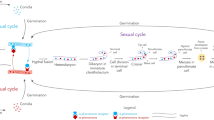Abstract
There are presently no studies on the genes for sexual development of Aspergillus fumigatus in situ using mating culture, primarily because of challenging experimental conditions that require a significantly long period of induction and produce developmentally heterogenous culture, harboring very few sexual organs. In order to overcome these challenges, we developed an efficient and convenient procedure called ‘vegetative mass mating (VeM)’ for study at a molecular level. The VeM method enabled production of a developmentally homogenous A. fumigatus culture, harboring many sexual organs in a plate within a short period of two weeks. Feasibility of the use of VeM for functional study of genes during A. fumigatus sexual development was evaluated by analyzing the transcription pattern of genes involved in pheromone signal transduction and regulation of sexual development. Here, we present for the first time, an in situ expression pattern of sexual genes during the mating process, induced by the VeM method, which will enable and promote the sexual development study of A. fumigatus at the molecular level.
Similar content being viewed by others
References
Bayram, Ö. and Braus, G.H. 2012. Coordination of secondary metabolism and development in fungi: The velvet family of regulatory proteins. FEMS Microbiol. Rev. 36, 1–24.
Dyer, P.S., Inderbitzin, P., and Debuchy, R. 2016. 14 Mating-type structure, function, regulation and evolution in the pezizomycotina, pp. 351–385. In Wendland, J. (ed.), Growth, differentiation and sexuality. The mycota (a comprehensive treatise on fungi as experimental systems for basic and applied research), vol I. Springer, Cham.
Dyer, P.S. and Kück, U. 2017. Sex and the imperfect fungi, pp. 193–214. In The fungal kingdom. American Society of Microbiology, Washington, D.C., USA.
Ene, I.V. and Bennett, R.J. 2014. The cryptic sexual strategies of human fungal pathogens. Nat. Rev. Microbiol. 12, 239–251.
Han, D.M., Han, Y.J., Lee, Y.H., Jahng, K.Y., Jahng, S.H., and Chae, K.S. 1990. Inhibitory conditions of asexual development and their application for the screening of mutants defective in sexual development. Korean J. Mycol. 18, 225–232.
Han, K.H., Han, K.Y., Yu, J.H., Chae, K.S., Jahng, K.Y., and Han, D.M. 2001. The nsdD gene encodes a putative GATA-type transcription factor necessary for sexual development of Aspergillus nidulans. Mol. Microbiol. 41, 299–309.
Han, K.H., Lee, D.B., Kim, J.H., Kim, M.S., Han, K.Y., Kim, W.S., Park, Y.S., Kim, H.B., and Han, D.M. 2003. Environmental factors affecting development of Aspergillus nidulans. J. Microbiol. 41, 34–40.
Han, K.H., Park, J.S., Chae, K.S., and Han, D.M. 2010. Simple identification of veA1 mutation in Aspergillus nidulans. J. Microbiol. 48, 885–887.
Kang, E.H., Kim, J., Oh, H.W., and Park, H.M. 2013. LAMMER kinase LkhA plays multiple roles in the vegetative growth and asexual and sexual development of Aspergillus nidulans. PLoS One 8, e58762.
Kim, H. and Borkovich, K.A. 2004. A pheromone receptor gene, pre-1, is essential for mating type-specific directional growth and fusion of trichogynes and female fertility in Neurospora crassa. Mol. Microbiol. 52, 1781–1798.
Kim, H.S., Han, K.Y., Kim, K.J., Han, D.M., Jahng, K.Y., and Chae, K.S. 2002. The veA gene activates sexual development in Aspergillus nidulans. Fungal Genet. Biol. 37, 72–80.
Kong, Q., Wang, L., Liu, Z., Kwon, N.J., Kim, S.C., and Yu, J.H. 2013. Gβ-Like CpcB plays a crucial role for growth and development of Aspergillus nidulans and Aspergillus fumigatus. PLoS One 8, e70355.
Lee, M.K., Kwon, N.J., Lee, I.S., Jung, S., Kim, S.C., and Yu, J.H. 2016. Negative regulation and developmental competence in Aspergillus. Sci. Rep. 6, 1–13.
O’Gorman, C.M., Fuller, H.T., and Dyer, P.S. 2009. Discovery of a sexual cycle in the opportunistic fungal pathogen Aspergillus fumigatus. Nature 457, 471–474.
Palmer, J.M., Theisen, J.M., Duran, R.M., Grayburn, W.S., Calvo, A.M., and Keller, N.P. 2013. Secondary metabolism and development is mediated by LlmF control of VeA subcellular localization in Aspergillus nidulans. PLoS Genet. 9, e1003193.
Paoletti, M., Rydholm, C., Schwier, E.U., Anderson, M.J., Szakacs, G., Lutzoni, F., Debeaupuis, J.P., Latgé, J.P., Denning, D.W., and Dyer, P.S. 2005. Evidence for sexuality in the opportunistic fungal pathogen Aspergillus fumigatus. Curr. Biol. 15, 1242–1248.
Park, H.S., Bayram, Ö., Braus, G.H., Kim, S.C., and Yu, J.H. 2012. Characterization of the velvet regulators in Aspergillus fumigatus. Mol. Microbiol. 86, 937–953.
Sugui, J.A., Kwon-Chung, K.J., Juvvadi, P.R., Latgé, J.P., and Steinbach, W.J. 2015. Aspergillus fumigatus and related species. Cold Spring Harb. Perspect. Med. 5, 1–18.
Sugui, J.A., Losada, L., and Wang, W. 2011. Idenetification and characterization of an Aspergillu fumigatus “supermater” pair. mBio 2, e00234–11.
Szewczyk, E. and Krappmann, S. 2010. Conserved regulators of mating are essential for Aspergillus fumigatus cleistothecium formation. Eukaryot. Cell 9, 774–783.
Tashiro, T., Izumikawa, K., Tashiro, M., Takazono, T., Morinaga, Y., Yamamoto, K., Imamura, Y., Miyazaki, T., Seki, M., Kakeya, H., et al. 2011. Diagnostic significance of Aspergillus species isolated from respiratory samples in an adult pneumology ward. Med. Mycol. 49, 581–587.
Vallim, M.A., Miller, K.Y., and Miller, B.L. 2000. Aspergillus SteA (sterile12-like) is a homeodomain-C2/H2-Zn+2 finger transcription factor required for sexual reproduction. Mol. Microbiol. 36, 290–301.
Yu, Y., Blachowicz, A., Will, C., Szewczyk, E., Glenn, S., Gensberger-Reigl, S., Nowrousian, M., Wang, C.C.C., and Krappmann, S. 2018. Mating-type factor-specific regulation of the fumagillin/pseurotin secondary metabolite supercluster in Aspergillus fumigatus. Mol. Microbiol. 110, 1045–1065.
Acknowledgements
A special volunteer program was kindly provided to LJY by Dr. P. Williams and Dr. K.J. Kwon-Chung of the NIAID/NIH, USA. Travel and living expenses for the special volunteer program was funded by BK21+ CNUBioBC, Korea. This research was supported by the Basic Science Research Program through the National Research Foundation of Korea (NRF) by the Ministry of Education (Grant No. 2016-2307).
Author information
Authors and Affiliations
Corresponding author
Rights and permissions
About this article
Cite this article
Lim, JY., Park, HM. Expression of sexual genes in Aspergillus fumigatus homogeneous culture produced by vegetative mass mating. J Microbiol. 57, 688–693 (2019). https://doi.org/10.1007/s12275-019-9094-7
Received:
Revised:
Accepted:
Published:
Issue Date:
DOI: https://doi.org/10.1007/s12275-019-9094-7




